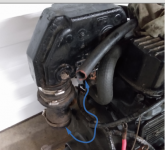The "new for me" inline 6 came off an old timer's boat that had been sitting in
a garage (apparently heated) since he had some health issues several years back.
My "free boat" had a cracked block. I checked the dip stick when I got the engine and
it was "only black", no sign of water whatsoever. The riser elbow was pretty rusted,
and it had been removed, but was packed with the engine. I put on the elbow from the engine with the cracked block (riser and manifold look good to my untrained eye).
Cranked up the new engine on a pallet and it sounded like a tiger purring.
I ran it for several minutes and it just hummed along. Accelerated just for a moment a couple of times, and there was instant power without any hesitation. I shut down and decided to change the oil. Now the dipstick was that color we don't speak of - kind of grey and milky. I drained the oil and it was slushy grey. I refilled the engine, ran it a bit, and drained the fresh oil. A little thin, but black, not grey.
A few thoughts come to mind-
1) Cracked block - say it isn't so! The block, heads and oil pan are pristine. No signs of exterior cracks. I hope this isn't the problem...
2) My water pressure (I ran a hose into the water line that would normally come from the impeller on the outdrive) may have been too high. But I ran only a modest amount of water, although the water was pretty cool at the exhaust. Could too high water pressure cause water to flow back into the manifold and get into the oil somehow?
3) Crack/leak/hole in manifold - I like this the best because I have another manifold (from the old engine) and could switch it out. Since the riser elbow was rusted pretty badly, I'm thinking that the manifold may have been compromised as well. Maybe that's why the previous owner had taken it apart (before, or maybe at the beginning of Alzheimer's).
Any ideas, suggestions for further diagnosis? I'm surprised that the engine could start so easily and sound so good with this kind of major issue!
Thanks for your ideas!
a garage (apparently heated) since he had some health issues several years back.
My "free boat" had a cracked block. I checked the dip stick when I got the engine and
it was "only black", no sign of water whatsoever. The riser elbow was pretty rusted,
and it had been removed, but was packed with the engine. I put on the elbow from the engine with the cracked block (riser and manifold look good to my untrained eye).
Cranked up the new engine on a pallet and it sounded like a tiger purring.
I ran it for several minutes and it just hummed along. Accelerated just for a moment a couple of times, and there was instant power without any hesitation. I shut down and decided to change the oil. Now the dipstick was that color we don't speak of - kind of grey and milky. I drained the oil and it was slushy grey. I refilled the engine, ran it a bit, and drained the fresh oil. A little thin, but black, not grey.
A few thoughts come to mind-
1) Cracked block - say it isn't so! The block, heads and oil pan are pristine. No signs of exterior cracks. I hope this isn't the problem...
2) My water pressure (I ran a hose into the water line that would normally come from the impeller on the outdrive) may have been too high. But I ran only a modest amount of water, although the water was pretty cool at the exhaust. Could too high water pressure cause water to flow back into the manifold and get into the oil somehow?
3) Crack/leak/hole in manifold - I like this the best because I have another manifold (from the old engine) and could switch it out. Since the riser elbow was rusted pretty badly, I'm thinking that the manifold may have been compromised as well. Maybe that's why the previous owner had taken it apart (before, or maybe at the beginning of Alzheimer's).
Any ideas, suggestions for further diagnosis? I'm surprised that the engine could start so easily and sound so good with this kind of major issue!
Thanks for your ideas!




















